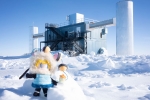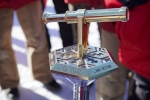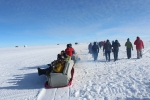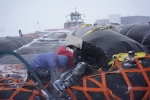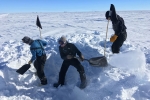Even though the end of the summer season feels like it’s fast approaching, things have still been busy at the South Pole. Work got underway for both the new surface radio antennas and the new IceAct telescopes.
There were different groups of South Pole visitors last week—some human, and some not. The nonhuman visitor came from Japan—IceCube-san, seen here on the snow outside the IceCube Lab. The other visitors were adventure travelers, who were based at a campsite not far from the station.
Last week at the Pole started in 2018 but ended in 2019. What better way to launch into the new year than by unveiling something shiny and bright? That’s the tradition at the South Pole, with a special ceremony held each January 1 to reset the marker at the geographic South Pole.
There are so many different ways to celebrate the holidays around the world, but there’s only one special event that actually takes you around the world. It’s the occasion of the annual “Race Around the World” at the South Pole—a fun run that circles around the South Pole, traversing all of the world’s time zones.
The second South Pole Overland Traverse (SPOT) arrived and toured the IceCube Lab last week. Defueling the SPOT bladders can be a rough job, especially if the weather’s bad.
Another action-packed week at the Pole. IceCube was relatively quiet, but some amazing sun dogs garnered folks’ attention. The station celebrated the 107th anniversary of Roald Amundsen’s arrival at the South Pole, with the station manager dressed up as Amundsen for a photo shoot at the geographic South Pole.
An action-packed week with summer activities in full swing. There was lots of work in the field—digging, measuring, installing equipment.
In an attempt to better understand the anisotropy, the IceCube Neutrino Observatory and the HAWC gamma-ray observatory have united their efforts to study cosmic-ray arrival directions in both hemispheres at the same primary energy. The goal of this combined observation was to get a nearly full-sky coverage to study the propagation of cosmic rays with median energy of 10 TeV through our local interstellar medium as well as the interactions between interstellar and heliospheric magnetic fields. Results have just been accepted for publication in The Astrophysical Journal and include measurements on how the anisotropy modulations are distributed over different angular scales.


